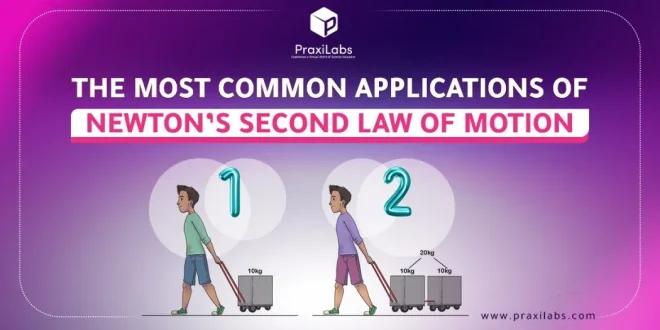Last Updated on October 11, 2025 by Muhamed Elmesery
Newton’s laws of motion are three physical laws that establish the science of kinematics. These laws describe the relationship between the motion of an object and the force acting on it. They are essential because they are the foundation of classical mechanics, one of the main branches of physics. It was Isaac Newton who established these laws, and he used these laws to explain many physical systems and phenomena.
In this article, we will focus on the most common examples and applications of Newton’s second law of motion in daily life.
Newton’s second law studies the movement of an object when external forces affect it. When a constant force affects a huge object, it causes it to accelerate, that is, to change its speed, at a constant rate.
Newton’s second law is a quantitative description of the changes that a force can produce on the motion of a body. It states that the time rate of change of the momentum of a body is equal in both magnitude and direction to the force imposed on it.
discover praxilabs the best lab simulation
Table of Contents
Sir Isaac Newton
If we are going to talk about classical mechanics and applications of Newton’s second law of motion in daily life, we must first shed light on the founder of these laws and the one who has the credit for bringing them out to us, Sir Isaac Newton. Here are some quick facts about Isaac Newton.
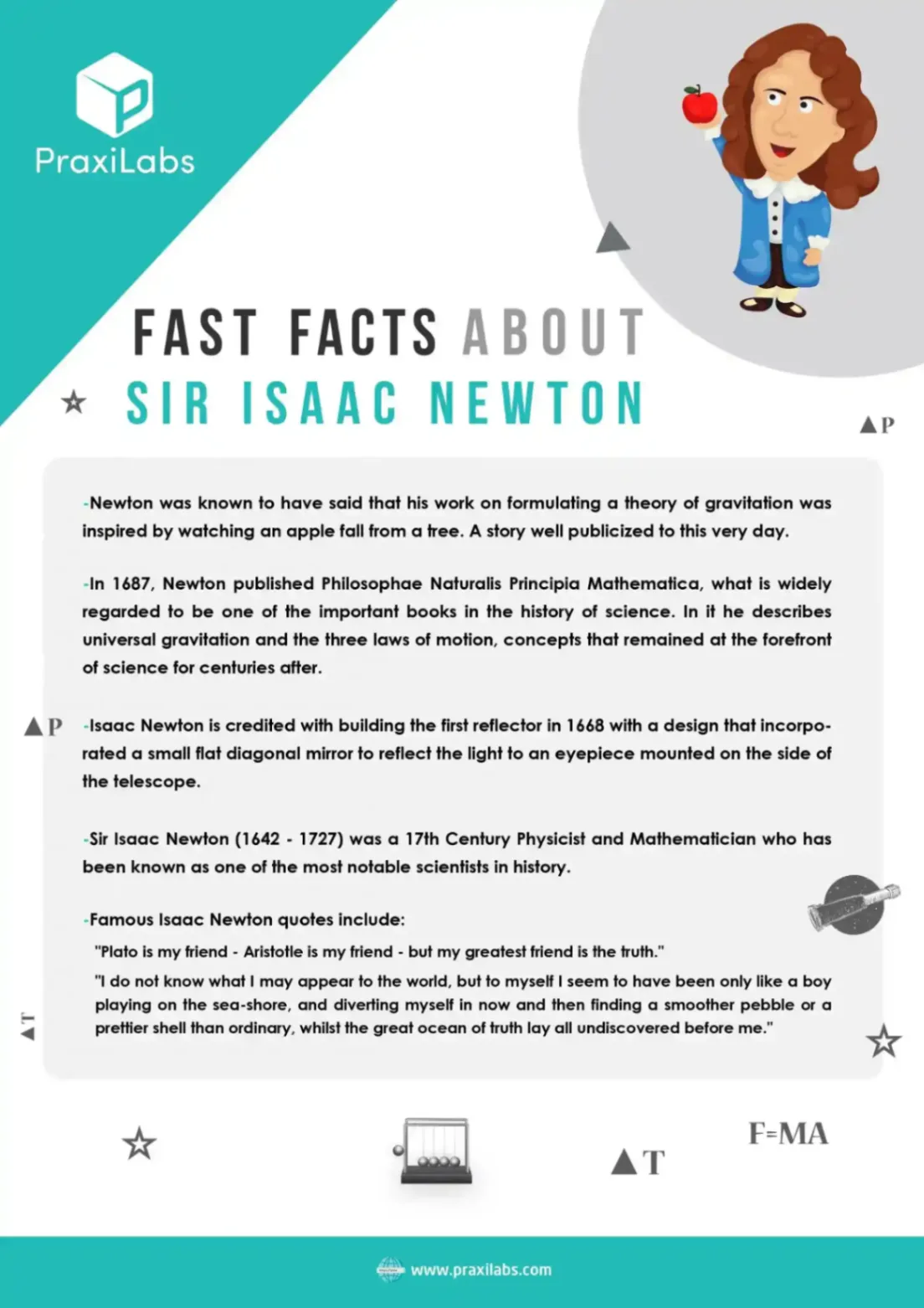
Newton’s laws of motion were first published by Isaac Newton in his Philosophiæ Naturalis Principia Mathematica in 1687 in 1687, which is the basis of classical mechanics. Newton used these laws to explain and investigate many physical phenomena. Newton showed that these laws in addition to the law of universal gravitation are able to explain Kepler’s laws of planetary motion, and these laws are still among the most important physical laws so far.
For more information about Sir Isaac Newton and the other laws of motions, visit our article Applications of Newton’s Laws of Motion in Daily Life.
State and Prove Newton’s Second Law of Motion
“If a force affects an object, the object gains acceleration, proportional to its strength and inversely proportional to its mass.”
Newton’s Second Law Statement
Newton’s second law of motion states that the force applied to the system is equal to the time rate of change of momentum.
- So, F=dP/dt
- But P=mv
- So, F=d(mv)/dt
- Or F=m(dv/dvt)
- ⟹ F=ma
Notes
- Acceleration, a, is defined as a change in velocity, meaning a change in its magnitude or direction, or both.
- An external force is one acting on a system from outside the system, as opposed to internal forces, which act between components within the system.
- Newton’s second law of motion states that the acceleration of a system is directly proportional to and in the same direction as the net external force acting on the system, and inversely proportional to its mass.
- In equation form, Newton’s second law of motion is a=Fnetma=Fnetm.
- This is often written in the more familiar form: Fnet = ma.
- The weight w of an object is defined as the force of gravity acting on an object of mass m. The object experiences an acceleration due to gravity g:
w = mg.
- If the only force acting on an object is due to gravity, the object is in free fall.
- Friction is a force that opposes the motion past each other of objects that are touching.
Newton’s second law studies the movement of an object when external forces affect it. When a constant force affects a huge object, it causes it to accelerate, that is, to change its speed, at a constant rate.
In the simplest case, the force acting on an object at rest causes it to accelerate in the direction of the force. However, if the object is indeed in motion it may appear that the object is speeding up, slowing down, or changing its direction depending on the direction of force, directions taken by the object, and the frame of reference in which it is moving Relative to each other.
Mathematically, Newton’s second law can be expressed through the following equation:
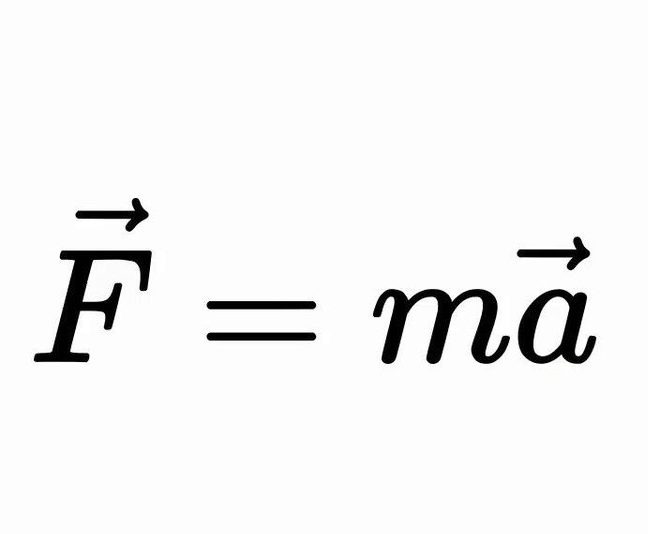
where F is the resultant force, m is the mass of the object, and a is the acceleration of the body.
This relationship applies the principle of preserving the momentum, which is that when the sum of the resultant forces acting on the object is equal to zero, the momentum of the object remains constant. The resultant force is equal to the rate of change in the momentum.
This law also means that when two equal forces act on two different bodies, the object with greater mass will have less acceleration and slower motion, and the object with less mass has greater acceleration. For example, to illustrate:
If we have two similar engines, one for a large car and the other for a small car, then the small one will have more acceleration because its mass is less and the large one will have less acceleration because its mass is greater.
Explanatory Video of Newton’s Second Law
You can try PraxiLabs virtual lab for online Physics experiments … Subscribe now and select your plan
10 Examples of Newton’s Second Law of Motion in Everyday Life
We always see the applications of Newton’s second law of motion in daily life when:
1- Try to move an object
like stopping a moving ball rolling on the ground.
2- Pushing a car and a truck
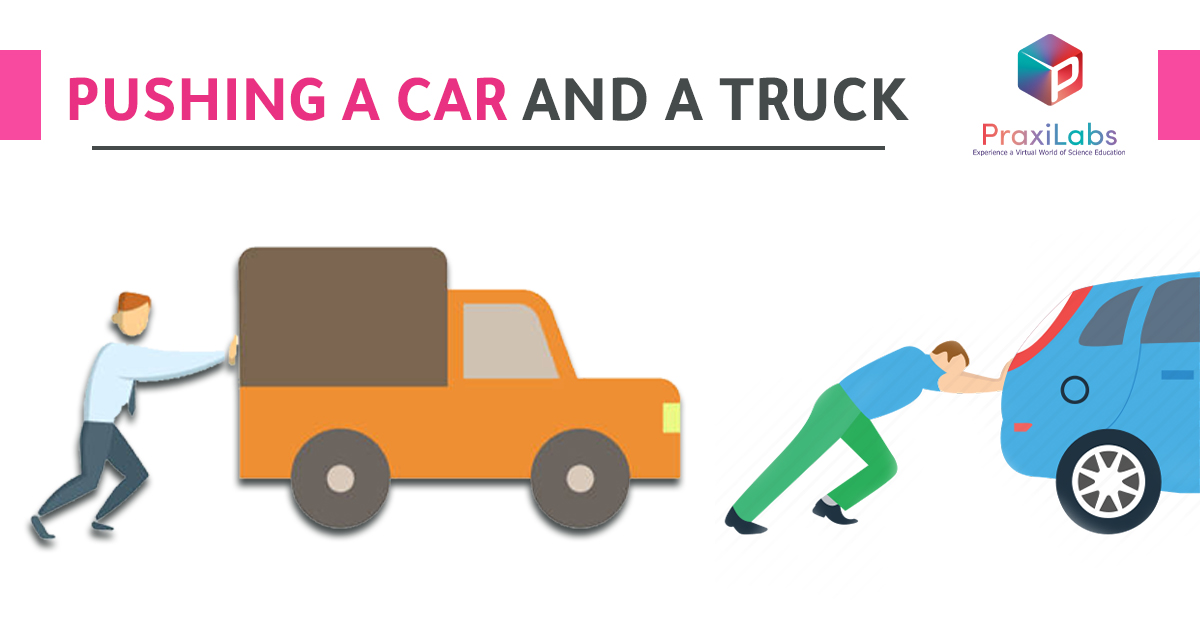
Newton’s second law of motion can be observed by comparing the acceleration produced in a car and a truck after applying an equal magnitude of force to both. It is easy to notice that after pushing a car and a truck with the same intensity, the car accelerates more than the truck. This is because the mass of the car is less than the mass of the truck.
3- Racing Cars
Reducing the weight of racing cars to increase their speed, engineers try to keep vehicle mass as low as possible, as lower mass means more acceleration, and the higher the acceleration the greater the chances of winning the race.

4- Rocket launch
For a rocket to leave the earth’s orbit and enter outer space, a force called thrust is required. As per the second law of motion given by Sir Issac Newton, the force is proportional to the acceleration; therefore, to launch a rocket, the magnitude of thrust is increased, which in turn increases the acceleration. The speed achieved by the rocket finally helps it to escape the earth’s gravitational field and enter space.
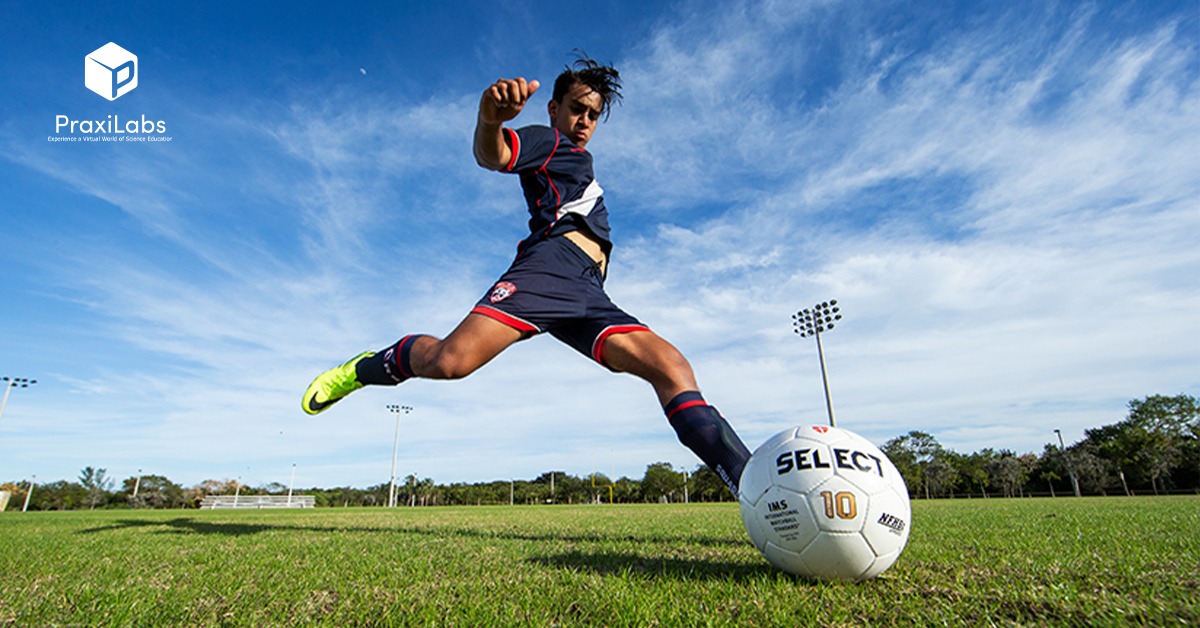
5- Kick the ball
When we kick the ball we exert force in a specific direction, which is the direction the ball will move. In addition, the more forcefully the ball is kicked, the more force we apply to it and the further away the ball is.
6- Car crash
During a car crash, there exists a force between the obstacle and the car, which is known as the impact force. The magnitude of the impact force depends on the mass of the objects involved in the collision and the speed with which the objects move. This means that the greater the mass of the objects involved in the collision, the more will be the intensity of the impact force. Similarly, the more the acceleration with which the car moves, the greater will be the magnitude of the impact force.
7- Two people walking
Of the two walking people, if one is heavier than the other, the one who weighs the heaviest walks slower because the acceleration of the one who weighs the lighter is more.
8- Object thrown from a height
When an object is thrown from a certain height, the gravitational pull of the earth helps it to develop acceleration. The acceleration increases as the object advanced towards the earth. According to Newton’s second law of motion, the acceleration developed by a body is directly proportional to the force. When the object hits the ground, the impact force comes into action. This is the reason why a brittle object thrown from a tall building suffers more deformity than the situation where the same object is thrown from a comparatively shorter building.
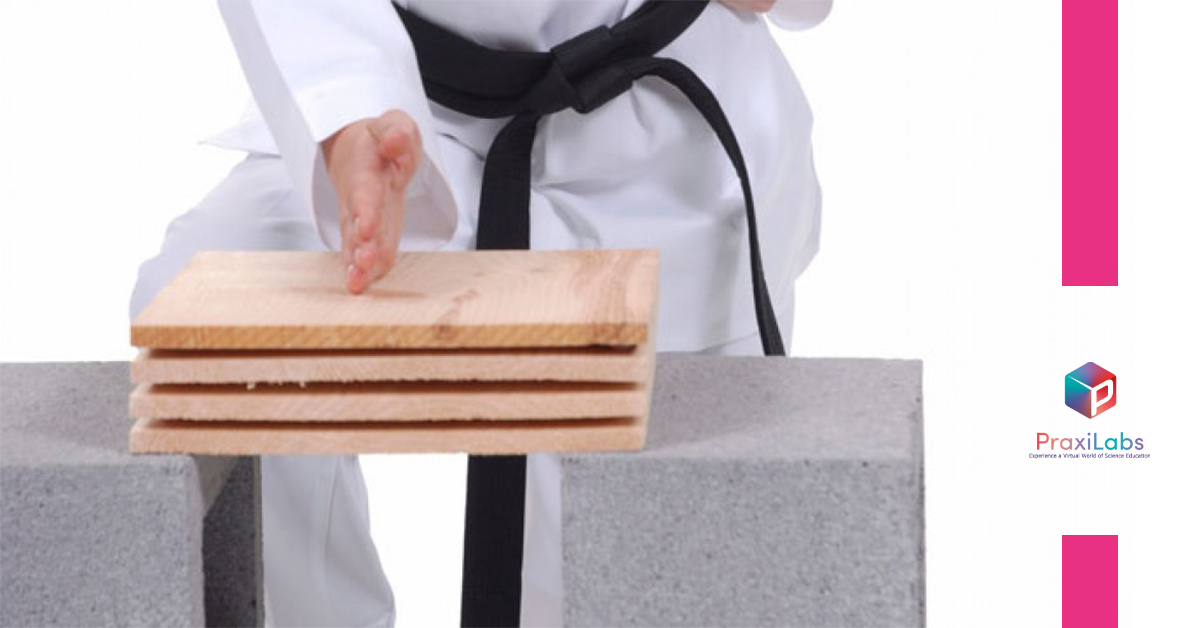
9- Karate player breaking slab of bricks
A karate player makes use of the second law of motion to perform the task of breaking a slab of bricks. Since, according to law, the force is proportional to the acceleration, the player tends to move his/her hands over the slab of bricks swiftly. This helps him/her to gain acceleration and produce a proportionate amount of force. The force is sufficient enough to break the bricks.
10- Driving a car
In simple terms, Newton’s second law of motion states that if force is applied to any object that has mass, it will result in the production of an equivalent amount of acceleration in the object. For instance, when we turn on the ignition system of the car, the engine of the car produces sufficient force that enables the car to move with proportionate acceleration.
Applications of Newton’s Second Law of Motion in Sports
Newton’s laws of motion form the basis for principles used in sport movements. Methods of training that depart from these laws would not make sense mechanically. Tips for efficient sport performances are built around these laws and principles.

- Baseball
Normally, baseball is at rest, It needs external force to move: gets thrown or is hit. The distance the ball travels depends on the amount of force that acts on it.
If a baseball player hits a ball with double the force, the rate at which the ball will accelerate (speed up) will be doubled
- Tennis
A ball develops a certain amount of acceleration after being hit. The acceleration with which the ball moves is directly proportional to the force applied to it. This means that the harder you hit the ball, the faster it will move, thereby demonstrating Newton’s second law of motion in daily life.
- Karate Player Breaking Slab of Bricks
A karate player makes use of the second law of motion to perform the task of breaking a slab of bricks. Since, according to law, the force is proportional to the acceleration, the player tends to move his/her hands over the slab of bricks swiftly. This helps him/her to gain acceleration and produce a proportionate amount of force. The force is sufficient enough to break the bricks.
- Football
Football players can slow down, stop, or reverse the direction of other players depending upon how much force they can generate and in which direction.
When we kick the ball we exert force in a specific direction, which is the direction the ball will move. In addition, the more forcefully the ball is kicked, the more force we apply to it and the further away the ball is.
Get Started Praxilabs For FREE

Law of Acceleration Examples in Real Life
- It is easier to push an empty shopping cart than a full one, because the full shopping cart has more mass than the empty one. This means that more force is required to push the shopping cart.
- Law of acceleration can be observed by comparing the acceleration produced in a car and a truck after applying an equal magnitude of force to both. It is easy to notice that after pushing a car and a truck with the same intensity, the car accelerates more than the truck.
(If you use the same force to push a truck and a car, the car will have more acceleration than the truck because the car has less mass.)
- If a car turns a corner at constant speed, it is accelerating because its direction is changing. The quicker you turn, the greater the acceleration. So there is an acceleration when velocity changes either in magnitude (an increase or decrease in speed) or in direction, or both.
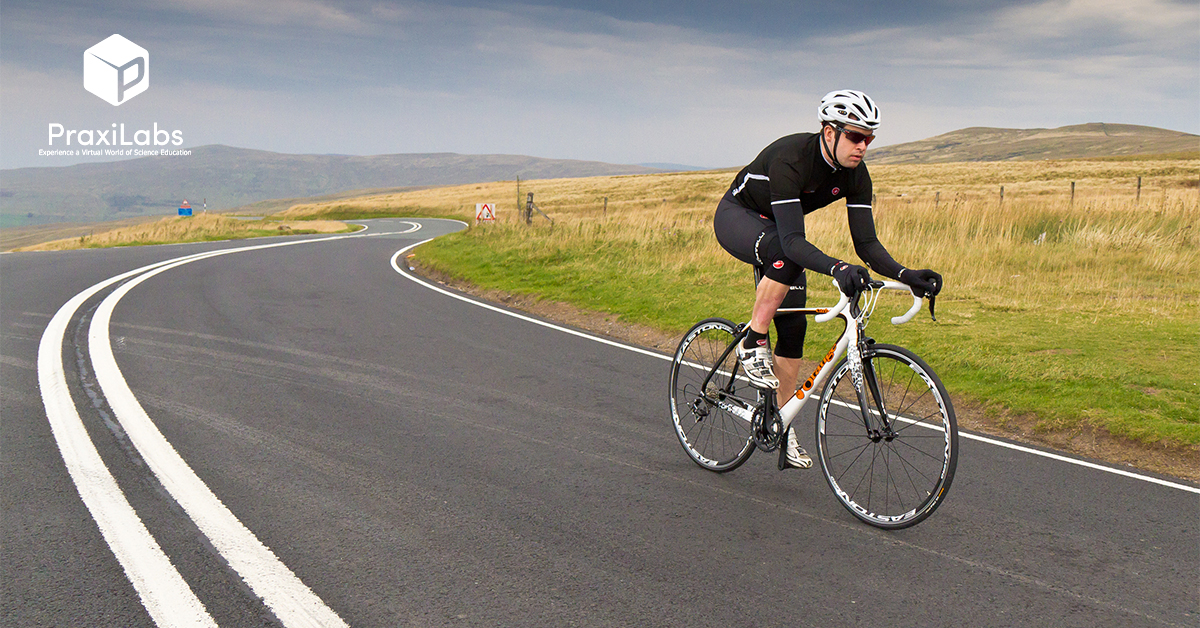
Real Life Examples of Newton’s Second Law
- Riding your bicycle is a good example of this law of motion at work. Your bicycle is the mass. Your leg muscles pushing on the pedals of your bicycle is the force. When you push on the pedals, your bicycle accelerates. You are increasing the speed of the bicycle by applying force to the pedals.
- When traveling in a car, when the car accelerates, we feel the back of our seat pushing us forward. The back of our seat operates force on our back which is proportional to the acceleration and our weight (mass).
- When an object falls in a free fall onto the ground, it accelerates because the force of gravity of earth pulls it.
Quick Questions and Answers about the Application of Newton’s Second Law of Motion
Which Technology Uses Newton’s Second Laws of motion?
There are lots of technologies based on Newton’s laws of motion. For example, Newton’s second law of motion provides the foundation for much of the mathematics in engineering mechanics.
In the study of dynamics, engineers apply Newton’s second law to predict the motion of an object experiencing a net force. Using the equation F = ma, engineers can model the position, velocity and acceleration of an object, or they can measure these values to learn about the forces acting on the object.
In the field of statics, engineers use Newton’s second law to calculate forces acting upon stationary objects. Because a non-moving object’s acceleration is zero, the forces acting on the object must sum to zero. For example, in designing structures, engineers apply Newton’s second law in calculating the forces acting on joints in the framework of buildings and bridges.
How Can Newton’s First Law of Motion Be Obtained from the Second Law of Motion?
When net force is zero and when moving with constant speed.
Newton’s first law of motion states that a body at rest will remain at rest unless an outside force acts on it, and a body in motion at a constant velocity will remain in motion in a straight line unless acted upon by an outside force.
If a body experiences an acceleration ( or deceleration) or a change in direction of motion, it must have an outside force acting on it. Outside forces are sometimes called net forces or unbalanced forces.
The second law of motion states that if an unbalanced force acts on a body, that body will experience acceleration (or deceleration), that is, a change of speed.
So, Outside forces are sometimes called net forces. If net force acting on a moving body is zero, the body will be at a constant velocity. Thus Newton’s first law of motion can be obtained from the second law of motion.
How Does the First Law of Motion Lie in the Second Law of Motion?
Newton’s first law of motion states that a body will stay at rest or continue its path with constant velocity unless an external force acts upon it.
Newton’s second law of motion states that the net force that acts upon a body is equal to the mass of the body multiplied by the acceleration due to the net force. In other words, Fnet=ma.
Now, one can argue that Newton’s second law of motion leads to the first law. Consider this: since Fnet=ma, with zero net force (no external forces), 0=ma.
Now, m is some finite positive value. In other words, this means that a=0. By definition, then, there is constant velocity (possibly constant zero velocity). Thus, it seems that Newton’s second law of motion leads to the first law.
Why Is the Second Law of Motion the Most Important?
Newton’s second law of motion F=ma is very important because it shows the relationship between forces and motion. It allows you to calculate the acceleration (and therefore velocity and position) of an object with known forces. This is incredibly valuable for scientists, engineers, inventors, etc.
What Are the Two Factors that Affect Newton’s Second Law?
The second law states that the acceleration of an object is dependent upon two variables – the net force acting upon the object and the mass of the object. The acceleration of an object depends directly upon the net force acting upon the object, and inversely upon the mass of the object.

Praxilabs Virtual Labs in Mechanical Physics
PraxiLabs virtual science labs enable you to conduct various laboratory experiments in physics, chemistry and biology online anytime and anywhere.
Create your free account and try now the virtual labs in mechanics that explain Newton’s laws of motion and applications of newton’s laws of motion in daily life.
 PraxiLabs A virtual world of science
PraxiLabs A virtual world of science

